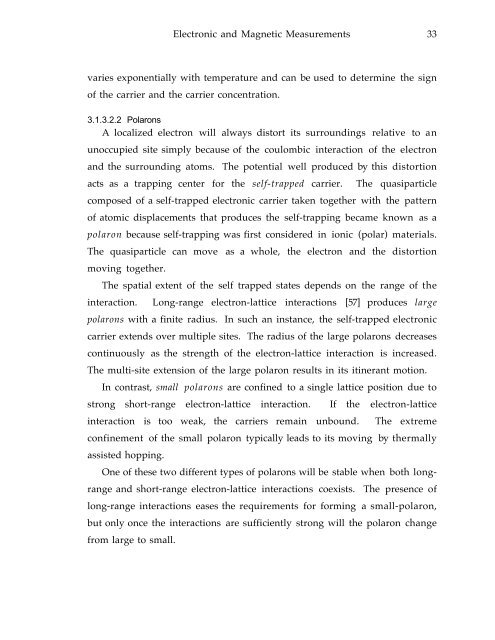MAGNETISM ELECTRON TRANSPORT MAGNETORESISTIVE LANTHANUM CALCIUM MANGANITE
MAGNETISM ELECTRON TRANSPORT MAGNETORESISTIVE LANTHANUM CALCIUM MANGANITE
MAGNETISM ELECTRON TRANSPORT MAGNETORESISTIVE LANTHANUM CALCIUM MANGANITE
You also want an ePaper? Increase the reach of your titles
YUMPU automatically turns print PDFs into web optimized ePapers that Google loves.
Electronic and Magnetic Measurements 33<br />
varies exponentially with temperature and can be used to determine the sign<br />
of the carrier and the carrier concentration.<br />
3.1.3.2.2 Polarons<br />
A localized electron will always distort its surroundings relative to an<br />
unoccupied site simply because of the coulombic interaction of the electron<br />
and the surrounding atoms. The potential well produced by this distortion<br />
acts as a trapping center for the self-trapped carrier. The quasiparticle<br />
composed of a self-trapped electronic carrier taken together with the pattern<br />
of atomic displacements that produces the self-trapping became known as a<br />
polaron because self-trapping was first considered in ionic (polar) materials.<br />
The quasiparticle can move as a whole, the electron and the distortion<br />
moving together.<br />
The spatial extent of the self trapped states depends on the range of the<br />
interaction. Long-range electron-lattice interactions [57] produces large<br />
polarons with a finite radius. In such an instance, the self-trapped electronic<br />
carrier extends over multiple sites. The radius of the large polarons decreases<br />
continuously as the strength of the electron-lattice interaction is increased.<br />
The multi-site extension of the large polaron results in its itinerant motion.<br />
In contrast, small polarons are confined to a single lattice position due to<br />
strong short-range electron-lattice interaction. If the electron-lattice<br />
interaction is too weak, the carriers remain unbound. The extreme<br />
confinement of the small polaron typically leads to its moving by thermally<br />
assisted hopping.<br />
One of these two different types of polarons will be stable when both long-<br />
range and short-range electron-lattice interactions coexists. The presence of<br />
long-range interactions eases the requirements for forming a small-polaron,<br />
but only once the interactions are sufficiently strong will the polaron change<br />
from large to small.
















